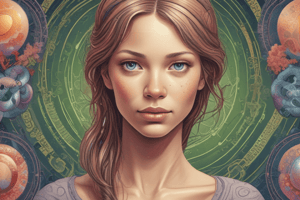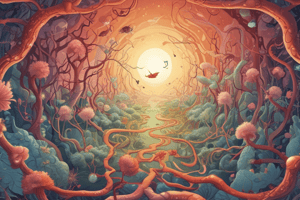Podcast
Questions and Answers
What is the study of the relationships between organisms and their environment?
What is the study of the relationships between organisms and their environment?
- Botany
- Microbiology
- Zoology (correct)
- Ecology
What is the study of the chemical processes and substances that occur within living organisms?
What is the study of the chemical processes and substances that occur within living organisms?
- Biophysics
- Ecology
- Genetics
- Biochemistry (correct)
What is the study of the structure, function, growth, evolution, distribution, and taxonomy of living organisms?
What is the study of the structure, function, growth, evolution, distribution, and taxonomy of living organisms?
- Biology (correct)
- Botany
- Zoology
- Microbiology
What is the study of the physical principles underlying biological processes?
What is the study of the physical principles underlying biological processes?
What is the study of heredity, genes, and genetic variation?
What is the study of heredity, genes, and genetic variation?
What is the study of microorganisms, such as bacteria and viruses?
What is the study of microorganisms, such as bacteria and viruses?
What is the study of plants and their interactions with the environment?
What is the study of plants and their interactions with the environment?
What is the study of animals and their interactions with the environment?
What is the study of animals and their interactions with the environment?
Flashcards are hidden until you start studying
Study Notes
Definition and Scope
- Biology is the scientific study of life and living organisms, including their structure, function, growth, evolution, distribution, and taxonomy.
- It explores the diversity of life forms, from molecules to ecosystems.
Branches of Biology
- Botany: study of plants and their interactions with the environment
- Zoology: study of animals and their interactions with the environment
- Microbiology: study of microorganisms, such as bacteria and viruses
- Ecology: study of the relationships between organisms and their environment
- Genetics: study of heredity, genes, and genetic variation
- Biochemistry: study of the chemical processes and substances that occur within living organisms
- Biophysics: study of the physical principles underlying biological processes
Biological Molecules
- Carbohydrates: energy source for cells, composed of carbon, hydrogen, and oxygen
- Proteins: building blocks of life, composed of amino acids
- Lipids: energy storage molecules, composed of fatty acids and glycerol
- Nucleic Acids: DNA and RNA, containing genetic information
Cell Biology
- Cell Structure: plasma membrane, cytoplasm, nucleus, mitochondria, ribosomes, lysosomes
- Cellular Processes: metabolism, photosynthesis, respiration, mitosis, meiosis
Evolution and Diversity
- Theory of Evolution: species change over time through natural selection, genetic drift, mutation, and gene flow
- Species Diversity: classification, taxonomy, and characteristics of different species
- Phylogeny: study of evolutionary relationships between organisms
Ecology and Ecosystems
- Ecosystem Components: biotic (living) and abiotic (non-living) factors
- Energy Flow: producers, consumers, decomposers, and energy transfer
- Population Dynamics: growth, limitation, and interactions between populations
Definition and Scope
- Biology is the scientific study of life and living organisms, exploring their structure, function, growth, evolution, distribution, and taxonomy.
Branches of Biology
- Botany explores the interactions between plants and their environment.
- Zoology examines the interactions between animals and their environment.
- Microbiology studies microorganisms, such as bacteria and viruses.
- Ecology examines the relationships between organisms and their environment.
- Genetics delves into heredity, genes, and genetic variation.
- Biochemistry investigates the chemical processes and substances within living organisms.
- Biophysics explores the physical principles underlying biological processes.
Biological Molecules
- Carbohydrates serve as an energy source for cells, composed of carbon, hydrogen, and oxygen.
- Proteins are the building blocks of life, consisting of amino acids.
- Lipids are energy storage molecules, comprising fatty acids and glycerol.
- Nucleic acids, including DNA and RNA, contain genetic information.
Cell Biology
- Cell structure consists of the plasma membrane, cytoplasm, nucleus, mitochondria, ribosomes, and lysosomes.
- Cellular processes include metabolism, photosynthesis, respiration, mitosis, and meiosis.
Evolution and Diversity
- The theory of evolution explains how species change over time through natural selection, genetic drift, mutation, and gene flow.
- Species diversity involves classification, taxonomy, and the characteristics of different species.
- Phylogeny is the study of evolutionary relationships between organisms.
Ecology and Ecosystems
- Ecosystem components consist of biotic (living) and abiotic (non-living) factors.
- Energy flow occurs through producers, consumers, decomposers, and energy transfer.
- Population dynamics involve growth, limitation, and interactions between populations.
Studying That Suits You
Use AI to generate personalized quizzes and flashcards to suit your learning preferences.




